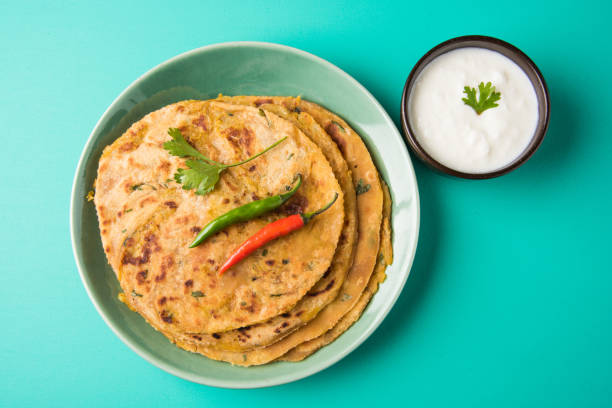Indian food is well-known for its vast variety of delicious dishes and its use of unusual ingredients like fragrant spices and fresh herbs. Multiple cuisines have emerged in the country as a result of its diverse cultural traditions. In India, morning parathas are a staple. Indian parathas are loaded with a variety of vegetables.
In this essay, I describe the traditional, healthy parathas that are prepared in nearly every Indian family, especially in the north. Parathas are a popular Indian flatbread that are both healthy and delicious. lists that follow
The first is a paratha stuffed with potatoes and onions (Aaloo-Pyaz).
Parathas made at home in large quantities of pure ghee and served with generous helpings of white butter are among the most popular types. What you should do to make parathas using potatoes:
The potatoes should be boiled before being peeled. Roughly chop some onions.
Season to taste with garam masala, green chilies, salt, and red chile.
Combine the potato and onion and mash them together with the spices.
You can choose between two different stuffings. To begin with:
Roll out two medium-sized balls of the dough using the well-kneaded wheat flour.
Spread a little of the potato and onion paratha filling on one of the rolled out dough discs.
To prevent the potatoes from leaking out, place another disc of dough on top and press the edges together.
To prevent the paratha from adhering to the hot griddle, dust it with dry flour before cooking it.
A second option is to use a slightly larger ball of dough and roll it out into a circle. The aaloo-pyaz filling should be placed in the middle of the rolled dough.
• Bring the edges together for some sass.
Use finger pressure to seal the ingredients together.
The swag should be rolled after the rolling board has been dusted with dry flour.
• In either method, the paratha is cooked on a sizzling griddle or tava.
The aaloo-pyaz paratha should be pan-fried in ghee till golden brown on both sides.
Paratha pairs nicely with ghee, butter, mango pickle, and yoghurt.
Gobhi (cauliflower) pancakes — Finely grate the gobhi, then mix it with some finely chopped green chilies.
Squeeze the gobi until you see no moisture at all.
• Season with salt, carom seeds, and red pepper flakes, and stir together.
• Make a wheat-flour dough the same size as you would for an aloo-pyaz paratha, and proceed with the same filling and cooking steps as you would with the aloo-pyaz paratha. Butter, yoghurt, mango pickle, and even coriander/mint chutney are additional accompaniments.
(3) Paneer (cottage cheese) Paratha.
This paratha is excellent and ranks high among my favourites. The steps for making paneer paratha are as follows.
Use your hands to grate or crumble the paneer until it is very fine.
Salt, powdered spices, and chopped green chilies should be added, then mixed thoroughly.
The dough should be around the size of a baseball and formed from kneaded wheat flour.
To facilitate rolling, stuff the container with grated paneer and dry flour.
• Fry in ghee on a hot tava (Indian griddle) or frying pan.
Served with a variety of condiments including butter, mango-chili pickle, coriander-mint chutney, yoghurt, and more.
Four, Spinach Paratha
The palak paratha is yet another delicious and nutritious paratha option. It’s a good alternative for kids who refuse to eat their vegetables because of the palak. Furthermore, it is the most common vegetarian diet in India. food eaten first thing in the morning.
Spinach leaves can be cleaned by rinsing them in water to remove any grit or grime.
Typically, spinach leaves are boiled, mashed, and then included into wheat flour. Aaloo-pyaz, gobhi, and paneer paratha are just a few of my favourite dishes in which I adore putting fresh leaves into the dough.
• If you’re using the first method, add the flour and knead it while adding the boiling spinach mixture, salt, carom seeds, green chilies, red chilies, one tablespoon of ghee, and a pinch of cayenne pepper.
Roll out a small piece of dough, and then fry it in ghee on a tava. Butter or yoghurt go well with hot spinach paratha.
But if you like paratha as much as I do, you’ll want to try it my way. Water should be thoroughly squeezed out of the spinach leaves after they have been washed and cut coarsely. It’s time to add those same spices we mentioned up top.
• Proceed in the same way you would with paneer or gobhi paratha.
Radish (Mooli) Paratha, No. 5.
My mom makes a killer paratha. Radish is most commonly prepared in the winter because it is more readily available then.
If you only have one mooli and it doesn’t have any leaves, peel the top layer off before shredding it.
• Remember that shredded radishes have a high water content; drain them before using in paratha.
Incorporate a pinch of carom seeds, a tablespoon of garam masala, a red chile, a green chile that has been finely diced, and some salt.
• You may stuff it with whatever you like and then fried it on the tava just like we did earlier.
• Accompany with mango pickle or coriander-mint-red chili-garlic chutney.
To ensure that the parathas remain soft even after being stored for a while, some recommend kneading the wheat flour with a tablespoon of ghee. In addition to preventing acid reflux and stomachaches, a small amount of carom seeds can be added to the stuffing. Methi parathas, chana dal methi, and sugar are also commonly consumed foods. Most vegetarian Indian restaurants and food courts will have all of these paranthas on the menu. Try everything; you won’t be sorry.
Veteran content maker Rohil Sharma has a penchant for traditional vegetarian dishes from India. He is an authority on vegetarianism and has written extensively about the best vegetarian diet and easy vegetarian meals.

